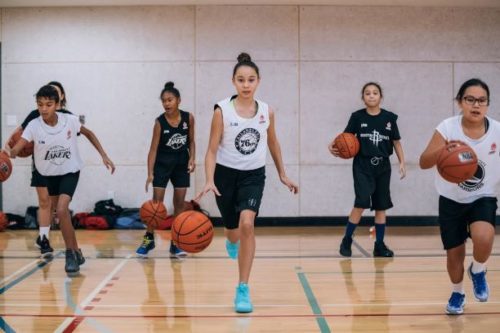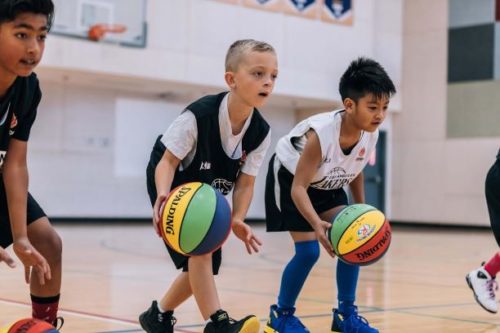Canada Basketball develops grassroots through Long-Term Development

Photos courtesy of Canada Basketball
Basketball is growing exponentially in Canada.
Over the past two decades, Canada Basketball has worked relentlessly to drastically improve participation and performance rates, bringing basketball neck-and-neck with soccer as the country’s most popular youth sport for participants between the ages of 6 and 17. Now the national sport organization is revamping their Long-Term Development framework to ensure age-appropriate delivery for their youngest athletes. Their focus is on creating an inclusive and fun environment that will keep more kids engaged for longer, while developing the necessary skills to succeed in the sport and in life.
“At the early stages of development, the goal is to help kids develop fundamental movement skills through basketball in a positive and fun way. By focusing on fun and ensuring success, we’re guiding them to develop a lifelong passion for basketball through enjoyment of the experience,” said Ron Yeung, Canada Basketball’s Director of Domestic Development.
“What we’re trying to accomplish with our youth program is to have all the kids engage with the sport to successfully develop the foundational movement skills they need to succeed in not only basketball, but also whatever different sports and activities they want to participate in. We’re person-first, or athlete-first, which means we’re focused on helping them develop physical skills, as well as mental and emotional life skills as they become active for life.”
In recent years, Canada Basketball rebranded their grassroots program to the Jr. NBA Youth Basketball program. By aligning their efforts with the NBA, the strategy is to capitalize on the excitement around the profile of the NBA and the Toronto Raptors’ recent success, to reassess their relationship with their communities, and then to push a grassroots movement in the country from coast to coast to coast. This has proven to be successful: Canada Basketball now has 22,000 participants in the program in 400 communities that cover 10 provinces and two territories. The program targets participants from five to 12 years old.
“The traditional method of coaching kids basketball through drills and repetitions is out-dated. We utilize a more creative and dynamic way to teach through games approach, where skills and activities can be learned through games, and the participants are having fun while they’re learning,” said Yeung.
The program also employs game modifications such as small-sided games, starting with one-on-one and two-on-two, and working their way up to four-on-four cross-court. By reducing the number of players when scrimmaging, it promotes better spacing and allows more opportunity for everybody to handle the ball in more meaningful possessions. Other game modifications included smaller-sized basketballs, lower hoops, and player-to-player defence, just to name a few.
Canada Basketball’s first Long-Term Development framework was established in 2008, with strong support from stakeholders across the country. Since then they’ve produced 24 draft picks into the NBA in a little over a decade, compared to 11 between 1974 and 2009. The women’s side produced 10 WNBA players in the last decade and the program is currently ranked fourth in the FIBA World Rankings.
According to Yeung, the next version of the framework will involve a bit of an overhaul that will better reflect the evolution of the game. Considering the organization’s successes over the last decade, the progression of this framework will focus on defining measurable performance indicators at each developmental stage, and connecting with the gold medal profile as the outcome. It will serve to be a living and breathing document for all Canadian basketball coaches, guiding the athletes through the pathway and achieving excellence in basketball.
“The idea is that it’s not just about physical and basketball skills development. Through a program like Jr. NBA, it is designed to address mental, cognitive and emotional development of a young athlete/person. Further to that, life skill topics such as teamwork, confidence, mindfulness, and emotional management are introduced and discussed at each session. These are important elements of an athlete’s development, and introducing them at a young age provides a strong foundation for athletes to achieve success at all stages of development down the road.”
Using Sport for Life’s resources, Canada Basketball has been able to reach out to parents so they understand the benefits of the Long-Term Development approach.
“We distribute a Jr. NBA parent guide that stems from Sport for Life’s parent education resources so that basketball parents can understand why early specialization is not recommended, the danger of competition for young athletes, a lot of different relevant topics, and that’s made a huge difference in getting everybody on the same page,” said Yeung.
Additionally, Canada Basketball has made strides towards addressing gender equity and safe sport.
 “We’ve been placing a greater emphasis in utilizing the profile of our Canadian women’s national team program, its athletes and coaches, to drive awareness towards female participation in basketball. A lot of it has to do with young female athletes being comfortable and having visible role models,” he said.
“We’ve been placing a greater emphasis in utilizing the profile of our Canadian women’s national team program, its athletes and coaches, to drive awareness towards female participation in basketball. A lot of it has to do with young female athletes being comfortable and having visible role models,” he said.
“With an increased focus on offering opportunities for female coaches to get additional education opportunities, the goal is to increase the female coaching pool at the grassroots level, creating a more comfortable and welcoming environment for young female participants to enter the sport.”
“In terms of safe sport, we introduced coaches screening two years ago as part of the requirement for coaches participation in the Jr. NBA program. This year, we will look to integrate safe sport training to further educate our coaches on the topic of maltreatment in sports. This is paramount in ensuring a safe and positive environment for our young athletes.”
Sport for Life CEO Richard Way has followed the successes of Canada Basketball, especially since Istvan Balyi and the Sport for Life team collaborated with the organization to begin conceptualizing their Long-Term Development framework back in 2002, before Sport Canada invested in all national sport organizations to develop their sport-specific frameworks. He believes the work Canada Basketball is doing to impact young lives deserves recognition, and sets a standard for youth programming that can be emulated by other sports across the country.
“When it comes to getting young athletes inspired and engaged, Canadian basketball is one of the success stories of our country,” said Way. “Now that we’ve established that we can appropriately develop world-class athletes and teams, it’s great that they’re doing further work to implement Long-Term Development and achieve alignment through the various stages of the pathway. I can’t wait to see what they accomplish with their new vision, and look forward to working with them as they touch the lives of countless Canadians.”

